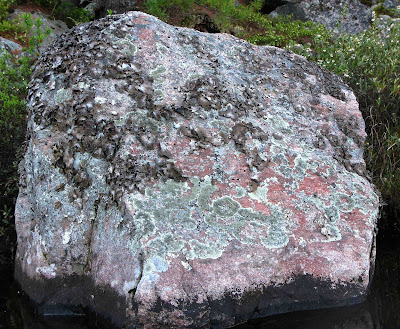Ed Miller's a native-plant enthusiast of great renown throughout the Albany/Adirondack region, a man of exhaustive botanical knowledge to whom many professional botanists turn when they want to know what grows where. A few posts back I recounted our trip to the Landis Arboretum, where Ed has almost single-handedly created a collection of New York native woody plants. Today, Ed took me to another of his remarkable spots: Joralemon Park in Coeymans, NY, a small town south of Albany. Adjoining this community park is a nature preserve that a former state chief botanist once called the best area he knew of for its botanical riches. Thanks to Ed's generosity (he personally put up the funds for the Nature Conservancy to purchase the land), this wooded area with a limestone substrate is now protected from further development.
The place reminded me a lot of the Skidmore woods, which has a similar limestoney soil and many of the same plants, including such rarities as Green Violet, Goldenseal, and Ginseng. One plant I've never found at Skidmore, though, is Virginia Waterleaf, which was growing abundantly in the Joralemon preserve. As was true for most of the woodland flowers, the waterleaf was long past its blooming time and was now bearing fruit.

One of the very few deep-woods blossoming plants was Lopseed, a flower I have never been able to photograph clearly, because it's so tiny and grows where the shade is so dark. A little sun filtered in to light up this one, but even so, it's not as clear as I'd like. The plant gets its name from its blossoms' habit of turning down to cling to the stalk when they form their seeds.
We found a large patch of Wild Leeks, a plant I found earlier this year up north in Warren County. Its deliciously edible leaves, also called Ramps, have long withered away so that all that remains by now are the flower stalks, going to seed.

This cluster of Harebells was crowning a limestone cliff overhanging an open marsh, the water below completely covered with several shades of green duckweeds. The spindly-stemmed Harebell normally grows as isolated individuals. I have never before seen it gather together into such a large clump.
Those limestone cliffs yielded many more remarkable botanical treasures. We found Creeping Shadblow and Fragrant Sumac (two shrubs I have never seen before in the wild) and many species of mosses and ferns. I was very glad to have Ed as my guide as we scoured the rocks, for he could point out to me many plants of interest, such as this tiny asplenium fern called Wall-rue. I'm certain I would never have seen it if Ed had not pointed it out. The whole clump was maybe two to three inches across.
That Wall-rue was a sure sign that the underlying rock was calcium rich, since it requires that nutrient for its very existence. The same could be said for a number of other ferns we found, such as Bulblet Fern, Fragile Fern, Walking Fern, Maidenhair Spleenwort, and the Ebony Spleenwort pictured here, so slender and gracefully curving.
I assumed this furry, spiky stuff was a moss, but Ed most kindly corrected my misunderstanding, explaining that this Rock Spikemoss (Selaginella rupestris) was more closely related to ferns than it was to mosses.

I won't go into the complicated botanical explanation -- it has something to do with it having a true vascular system, which mosses don't have and ferns do. Ed also had me look into its greenery with my magnifier to detect minute specks of bright yellow spores, another feature of the spikemoss's structure that sets it apart from regular mosses.
When I go on adventures like this one, with wonderfully knowledgeable folks like Ed, I become so aware of how much I still have to learn about the botanical riches that surround us. But I am also struck by how kind most plant-people are to students like me, how eager they are to share what they know with folks who express an interest. Thanks so much, Ed. I had a wonderful time.

















































